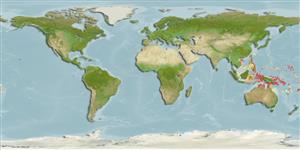>
Gobiiformes (Gobies) >
Gobiidae (Gobies) > Gobiinae
Etymology: Trimma: Greek, trimma, -atos = something crushed (Ref. 45335); pajama: Name from the Hindi word 'pajama', a loose clothing worn when retiring for the night, alluding to the contrasting stripes so common in at least the British version of that garment; noun in apposition.
Environment: milieu / climate zone / depth range / distribution range
Sinh thái học
Biển Cùng sống ở rạn san hô; Mức độ sâu 3 - 10 m (Ref. 96671). Tropical
Western Pacific: Indonesia and Papua New Guinea, with photographs and specimens from the Solomon Is. and Palau (Ref. 96671); and Tonga (Ref. 90102).
Bộ gần gũi / Khối lượng (Trọng lượng) / Age
Maturity: Lm ? range ? - ? cm
Max length : 1.6 cm SL (female)
Short description
Khóa để định loại | Hình thái học | Sinh trắc học
Các tia vây lưng cứng (tổng cộng) : 7; Các vây lưng mềm (tổng cộng) : 8; Tia cứng vây hậu môn: 1; Tia mềm vây hậu môn: 8. This species is distinguished by the following characters: predorsal midline with 6 scales; 2 ctenoid scales along the upper border of the opercle; cheek scaleless; first 2 dorsal spines slightly elongated and reaching posteriorly to between the base of the spine and the base of the first ray of the second dorsal fin; unbranched pectoral-fin rays; a fifth pelvic fin ray which branches once dichotomously and is 58-72% the length of the fourth ray; full basal membrane connecting the inner margins of the fifth pelvic fins rays in undamaged specimens; live colour pattern of red-orange and dark brown or grey stripes on the body reaching posteriorly to the anterior half of the caudal peduncle, it is unique among members of the genus, as is the preserved colour pattern of dark and light body stripes (Ref. 96671).
This species appears to be restricted to relatively shallow (3-10 m) reef areas protected from wave
exposure. Type specimens were collected exclusively from within beds of Halimeda macroalgae growing beneath branching Acropora coral stands. It is apparently the only species of the genus to be limited to this habitat (Ref. 96671).
Life cycle and mating behavior
Chín muồi sinh dục | Sự tái sinh sản | Đẻ trứng | Các trứng | Sự sinh sản | Ấu trùng
Winterbottom, R., M.V. Erdmann and N.K.D. Cahyani, 2014. Three new species of Trimma (Pisces; Gobioidei) from Indonesia. Zootaxa 3838(3):367-384. (Ref. 96671)
IUCN Red List Status (Ref. 130435: Version 2024-2)
Threat to humans
Harmless
Human uses
Các nghề cá: không ích lợi (thú vị)
Các công cụ
Special reports
Download XML
Các nguồn internet
Estimates based on models
Preferred temperature (Ref.
123201): 27.5 - 29.4, mean 28.8 °C (based on 999 cells).
Phylogenetic diversity index (Ref.
82804): PD
50 = 0.5000 [Uniqueness, from 0.5 = low to 2.0 = high].
Bayesian length-weight: a=0.01023 (0.00477 - 0.02194), b=3.01 (2.83 - 3.19), in cm total length, based on LWR estimates for this (Sub)family-body shape (Ref.
93245).
Thích nghi nhanh (Ref.
120179): Chiêù cao, thời gian nhân đôi của chủng quần tối thiểu là dưới 15 tháng (Preliminary K or Fecundity.).
Fishing Vulnerability (Ref.
59153): Low vulnerability (10 of 100).
